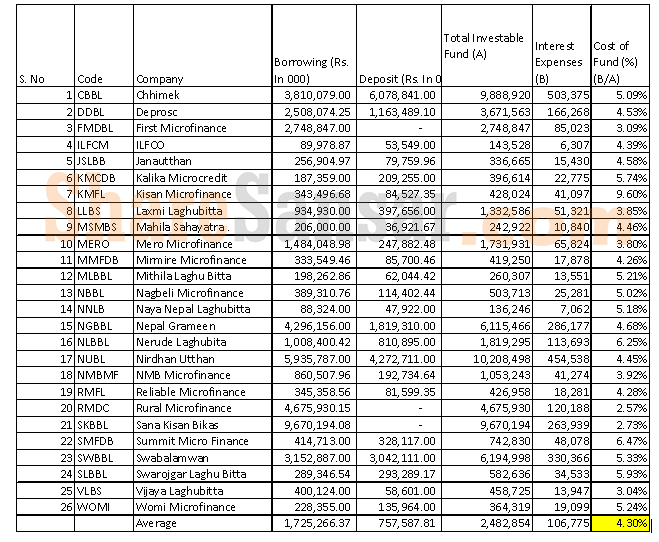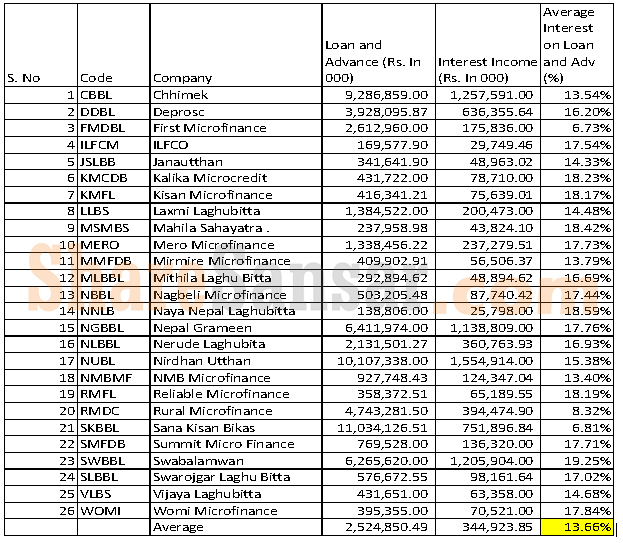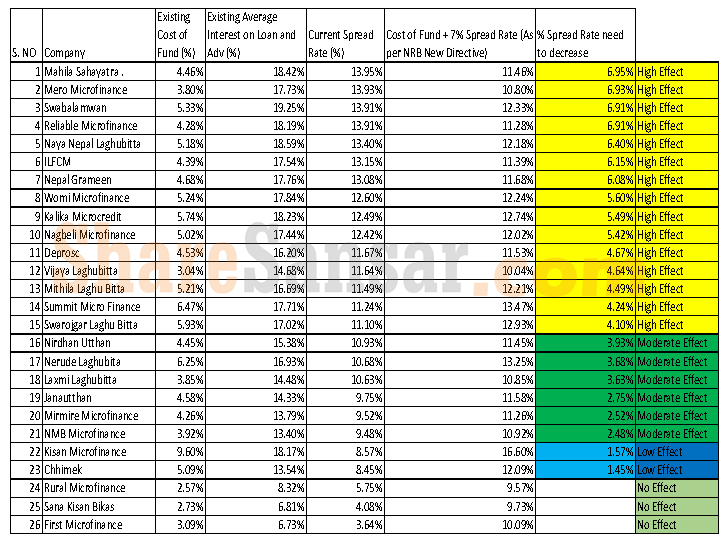Know how Microfinance companies' are affected by NRB directive to decrease Spread rate (Exclusive Study).
Sun, Sep 11, 2016 11:29 AM on Latest, Exclusive, Financial Analysis, Featured, Stock Market,

Nepal Rastra Bank through its Monetary Policy 2073/74 has directed all the microfinance companies to maintain spread rate up to 7 percent which means now microfinance companies can charge extra 7 percent margin based on their cost of fund.
Micro finance company which deals on micro credit provides services to the customers of rural area. They provide credit services based on group guarantee without any collateral and they get cheap fund from commercial banks and other institutions. Since they are operating in rural area where risk of doing business is very much high compared to city areas and they give loan without any collateral that’s the reason they charge high interest rate as compared to commercial banks.
But there are rumors and complains about microfinance institutions exploitation on locals by charging high interest rate. This is why Nepal Rastra Bank has tried to control this exploitation by putting cap on interest rate by fixing interest spread.
Microfinance sector, one of the best performing sectors on Nepal Stock Exchange, is regularly providing handsome dividend to shareholders since long due to its higher profitability ratio. Microfinance companies are one of the high priced companies in NEPSE recently.
After release of Monetary Policy 2073/74 by NRB, on an average the price of microfinance companies traded on Nepal Stock Exchange has declined by 25 percent on an assumption that the profitability ratio will decline in future.
ShareSansar has tried to find out the effects of these directives on the profitability of microfinance companies in coming days.
Since most of the microfinance companies did not published cost of fund and interest spread on its report, we directly calculated these ratios based on its income and expenses with loan amount and investable fund. So the calculated ratio will be just approximate figure.
 On an average, the overall cost of fund (approx) is 4.30% of microfinance institutions. Here, Kisan Microfinance has the highest cost of fund of 9.60% and Rural Microfinance has the least cost of fund of 2.57%.
On an average, the overall cost of fund (approx) is 4.30% of microfinance institutions. Here, Kisan Microfinance has the highest cost of fund of 9.60% and Rural Microfinance has the least cost of fund of 2.57%.
 On an average, the interest rate (approx. interest they are charging to its clients) microfinance companies are earning is 13.66%. Here, Swabalamban Laghubitta is earning average interest rate of 19.25% which means they are charging on an average 19.25% interest to its customers whereas Sana Kisan Bikas has low interest income of 6.81% but it is understood that wholesale microfinance has low rate of interest income.
On an average, the interest rate (approx. interest they are charging to its clients) microfinance companies are earning is 13.66%. Here, Swabalamban Laghubitta is earning average interest rate of 19.25% which means they are charging on an average 19.25% interest to its customers whereas Sana Kisan Bikas has low interest income of 6.81% but it is understood that wholesale microfinance has low rate of interest income.
 The above table shows that most of the microfinance companies’ profitability is going to be hit badly since they have to decrease their existing interest spread. Mahila Sahayatra Microfinance needs to decrease their existing spread rate by 6.95% (approx) which will badly hit their profitability in coming days. It seems that most of the microfinance companies’ profitability is going to decline by considerable amount due to their decreased spread rate as per NRB directives. Chhimek Lagubitta has very less effect despite of the new provision.
The wholesaler microfinance companies’ i.e. RMDC, SKBBL and FMDBL has no effect of this provision since their existing spread rate is below 7%.
Nepal Rastra Bank’s new directives to decline spread rate will definitely have positive effect in long run since this will lead to healthy competition among microfinance companies’ and the microfinance institutions are compelled to give quality service to its customers which leads to increase quality business in long run.
The above table shows that most of the microfinance companies’ profitability is going to be hit badly since they have to decrease their existing interest spread. Mahila Sahayatra Microfinance needs to decrease their existing spread rate by 6.95% (approx) which will badly hit their profitability in coming days. It seems that most of the microfinance companies’ profitability is going to decline by considerable amount due to their decreased spread rate as per NRB directives. Chhimek Lagubitta has very less effect despite of the new provision.
The wholesaler microfinance companies’ i.e. RMDC, SKBBL and FMDBL has no effect of this provision since their existing spread rate is below 7%.
Nepal Rastra Bank’s new directives to decline spread rate will definitely have positive effect in long run since this will lead to healthy competition among microfinance companies’ and the microfinance institutions are compelled to give quality service to its customers which leads to increase quality business in long run.
 On an average, the overall cost of fund (approx) is 4.30% of microfinance institutions. Here, Kisan Microfinance has the highest cost of fund of 9.60% and Rural Microfinance has the least cost of fund of 2.57%.
On an average, the overall cost of fund (approx) is 4.30% of microfinance institutions. Here, Kisan Microfinance has the highest cost of fund of 9.60% and Rural Microfinance has the least cost of fund of 2.57%.
 On an average, the interest rate (approx. interest they are charging to its clients) microfinance companies are earning is 13.66%. Here, Swabalamban Laghubitta is earning average interest rate of 19.25% which means they are charging on an average 19.25% interest to its customers whereas Sana Kisan Bikas has low interest income of 6.81% but it is understood that wholesale microfinance has low rate of interest income.
On an average, the interest rate (approx. interest they are charging to its clients) microfinance companies are earning is 13.66%. Here, Swabalamban Laghubitta is earning average interest rate of 19.25% which means they are charging on an average 19.25% interest to its customers whereas Sana Kisan Bikas has low interest income of 6.81% but it is understood that wholesale microfinance has low rate of interest income.
 The above table shows that most of the microfinance companies’ profitability is going to be hit badly since they have to decrease their existing interest spread. Mahila Sahayatra Microfinance needs to decrease their existing spread rate by 6.95% (approx) which will badly hit their profitability in coming days. It seems that most of the microfinance companies’ profitability is going to decline by considerable amount due to their decreased spread rate as per NRB directives. Chhimek Lagubitta has very less effect despite of the new provision.
The wholesaler microfinance companies’ i.e. RMDC, SKBBL and FMDBL has no effect of this provision since their existing spread rate is below 7%.
Nepal Rastra Bank’s new directives to decline spread rate will definitely have positive effect in long run since this will lead to healthy competition among microfinance companies’ and the microfinance institutions are compelled to give quality service to its customers which leads to increase quality business in long run.
The above table shows that most of the microfinance companies’ profitability is going to be hit badly since they have to decrease their existing interest spread. Mahila Sahayatra Microfinance needs to decrease their existing spread rate by 6.95% (approx) which will badly hit their profitability in coming days. It seems that most of the microfinance companies’ profitability is going to decline by considerable amount due to their decreased spread rate as per NRB directives. Chhimek Lagubitta has very less effect despite of the new provision.
The wholesaler microfinance companies’ i.e. RMDC, SKBBL and FMDBL has no effect of this provision since their existing spread rate is below 7%.
Nepal Rastra Bank’s new directives to decline spread rate will definitely have positive effect in long run since this will lead to healthy competition among microfinance companies’ and the microfinance institutions are compelled to give quality service to its customers which leads to increase quality business in long run.



